I am blogging on behalf of Trulia, but the views expressed here are solely mine, not Trulia’s. To learn more, visit: http://on.trulia.com/postcards.
I was raised primarily on a diet of HGTV and TLC, back when TLC used to produce shows like Trading Spaces, where for $1,000 and the chance to be on TV, a stranger might give you a tasteful new living room or intentionally pour bags of sand onto your basement floor, depending on the episode. Later in life I became enamored with the endless teachings of the Sovereign Queen Goddess Martha Stewart. At some point I discovered the Internet and found all of these kooky people blogging about their home renovations online. I casually studied architecture in college. And…that’s pretty much the start and end of my qualifications to own and renovate an old house. I grew up in new construction, and aside from some things I’d picked up here and there, I had no idea what I was doing.
Now that we’re coming up on a whole year of homeownership (that just flew by, didn’t it?), the folks at Trulia asked me to take part in a series they’ve put together about the most defining home buying moments—from making compromises to finding the right neighborhood to making an offer. For me, one of the biggest moments maybe wasn’t even really a moment at all, but more a sense of panic and impending doom about how little we knew in relation to how much had to be done. Both before and after we bought the house, there was just so much we didn’t know. It was completely terrifying. I had no idea how people bought houses. I had no idea I needed a lawyer. I had no idea what a boiler was. The thing I kept having to remind myself (and keep having to remind myself a lot of the time) is that knowing that you don’t know how something works is usually way scarier than finding out. This stuff isn’t rocket science. Once the mystery is removed from so many aspects of homeownership—from financing to renovating—they generally become way more approachable and easier to handle.
With that in mind, I thought I’d put together a more comprehensive post about some of the things I’ve learned in the first year about upgrading an old house, and maybe offer up some suggestions that we’ve taken advantage of (or tried to) to make it a little less daunting both mentally and financially. We have a ton of work ahead of us and I don’t think the learning process will ever end, but the house is still standing and we aren’t completely broke (yet!), so I guess we’re doing OK. Every house is different and comes with a different challenges, but a lot of what we’ve done in this first year is pretty typical of older homes. Let’s dive right in, shall we?

BEFORE YOU BUY
Our “house-hunting” story is so short it’s laughable. We weren’t looking for a house, or even thinking about buying one. But then we found one—on a weekend away from Brooklyn while staying at a house that our friends had rented around the corner in the Hudson River Valley city of Kingston, NY—and became completely obsessed with it in a way that’s honestly hard to describe. For us, this was never about buying a house—it was about having the opportunity to take care of this house, specifically. I loved everything about it: the original layout of beautifully-proportioned rooms, and all of the original features like moldings and doors and windows and plaster walls and radiators and even a beautiful marble fireplace mantel. And, honestly, I was attracted by how much work it needed. It was split up very awkwardly into two apartments, and we felt passionate about restoring it to a single family home and renovating it in a way that would be careful, deliberate, and respectful of its history. And even though the attachment I felt to the house was completely absurd and illogical, and that we didn’t really feel like we were in any position to buy a house, we both felt like we had to at least explore the option. If we never took that first leap to find out and it had eventually sold to somebody else, I honestly believe that I’d still be obsessing over it now. And probably five years from now. Maybe ten years. Maybe forever. I was in love with the house from the second I saw it, and immediately felt responsible for it even though it wasn’t ours. I know that might sound like overly-romantic nonsense, but it’s the truth.
All of this was basically driven by insanity is what I’m saying. But with old houses, that’s kind of important. Upgrading and renovating isn’t easy—emotionally, financially, socially, you name it—and I think you need to be a little nuts and a little obsessed to feel, at the end of the day, that you’re doing the right thing. And that you need to keep doing it.
Still, we weren’t complete idiots, and it certainly wasn’t as easy as just wanting it a whole lot. We had to think carefully about whether we were up for the challenge, and whether it seemed like a sound investment. If things went horribly awry, could we put it back on the market and walk away relatively financially unscathed? Could our relationship and lives sustain such a big upheaval? We felt like the answers were yes, but at that point there was just a lot of gut-trusting, blind passion, and leaps of faith. Those types of questions don’t really come with easy or simple answers. They still don’t some days, but that’s a whole different post.
While the process of buying the house was, as usual, incredibly stressful and time-consuming and intense and full of surprises outside of anyone’s control, it actually wasn’t as horribly difficult to navigate as I thought it would be. Our real estate agent was also the seller’s agent (the “seller” was an estate, the members of which all lived elsewhere…the previous owner of our house passed away a couple of years prior). She gave us lots of support and guidance throughout the process, and was invaluable for recommending home inspectors, local contractors, local lawyers, etc., and taking us through all the steps of making an offer, securing a loan, contingencies, and all of that. She even recommended a great real estate appraisal specialist through Property Valuers Brisbane, this recommendation has been super helpful for us during the whole process. This is the part of the process when you receive the most support and guidance, so use it! Ask TONS of questions about anything you’re unsure about. Agents are smart people. They know lots of things.
Aside from the expertise of your real estate agent, the most informative aspect of the pre-sale shenanigans is the inspections. You’ll probably get lots of inspections.
Because we felt very serious about the house, we hired a home inspector to come for our first walk-through.
I should note, I suppose, that all of this basically goes against traditional wisdom of home-buying. The seller’s agent, by definition, has the seller’s best interests at heart, and showing up for an initial walk-through with a home inspector basically lays all of your cards out on the table: we want this house—badly. But for us, I think it was a good thing. The seller’s agent was clearly excited about us and our evident infatuation with the house, and I truly believe that the genuine relationship we built with her really stacked the deck in our favor as we moved forward in the process.
ANYWAY—back to inspections. Typically realtors will have recommendations for a good home inspector, who will walk through the property and take note of any visible problems. Ours cost about $500. Inspectors are a great wealth of information, and should be able to answer all sorts of questions, bring up and discuss issues that they see, and even give ballpark estimates of how much certain repairs might cost. Of course, you should always verify these estimates with contractors, but it’s helpful to get a sense of whether the property is even worth pursuing further. The home inspector should prepare a detailed written report, which will not only be helpful for your own reference, but will often be essential information for insurance companies and banks. If the inspector notes things that were not disclosed or noted by the seller or seller’s agent, these might be helpful points to negotiate on the price. Based on what we gleaned from our home inspection and how long the property had been on the market, we felt comfortable submitting an offer of about 20% below asking price—which after some back and forth as various estimates came in is exactly what we ended up paying.
Assuming the home inspector’s report doesn’t leave you running away screaming, you’ll want to have a few more inspections and estimates to get an idea of what you’re looking at financially. In addition to a pest inspection to check for wood-destroying insects (which homeowners should ideally have done annually—I think it was about $100) which came up clean, we also walked through the house with both a locally licensed plumber and a locally licensed electrician. Both of these contractors should also be able to point out causes for concern, and help you formulate a list of probable repairs and upgrades you’ll need to make after closing. They should then provide written estimates for the anticipated work. For us, it was helpful to talk through best-case and worst-case scenarios with both of these contractors and get estimates for both. We also had three roofing contractors come to give estimates on replacing the faulty roof. All of this was free, and we’ve since used both the plumber and the electrician for all of our work—they’re great guys, and they’ve been with us since the beginning.
You may want to do additional inspections for radon, lead, and asbestos. This is kind of personal and kind of based on the house and location. Our house is almost 200 years old—it definitely has lead-based paint, and it does have asbestos in the typical places (like around some of the heat pipes in the basement), so testing for them was sort of a pointless expense. Both lead and asbestos do not present a hazard as long as they’re left undisturbed and intact, so there isn’t really any reason to invest in full-on lead or asbestos abatement in most cases.
Again, all houses are different, but at this point everyone should have a fairly comprehensive idea of what the house needs. You’ll have to figure out a loan and insurance and go back and forth endlessly on whether you can really afford it and there will generally be a lot of freaking out for weeks or months on end. You’ll sign a lot of things and feel like you’re throwing large amounts of money around willy-nilly and it will be insane and scary…and then you’ll get the keys. The whole team of people who helped you get to this point will give you a pat on the back and congratulations and then they’ll disappear into the ether and you have to start really figuring stuff out.
GENERAL UPGRADES
Aside from the fun and exciting cosmetic stuff that makes for entertaining blogging fodder, there were a few things that we needed to take care of ASAP:
1. Locks! If the existing locks are nice and new-ish, you can have a locksmith re-key them. We replaced all of ours with new, very secure ones. Prices obviously vary based on quality and whatnot, but our lock upgrade was about $120 per door, including the labor of the locksmith.
2. Security! While a home security system certainly isn’t mandatory, it gave us a significant amount of peace of mind to have one installed. Again, prices will vary based on what company you go with and what kind of equipment you use, but our system was about $800 in equipment, plus a monthly service bill which is about $60. Installing a central station security system and smoke detectors (meaning that if they trip, the police department or fire department are automatically called) also got us a nice discount on our homeowner’s insurance. Home security systems come in both wireless and hardwired options now, so it isn’t horribly expensive or invasive to have one installed if the house isn’t wired for it!
3. Smoke/Carbon Monoxide Detectors! Our house came with one smoke detector and one carbon monoxide detector. That’s not enough! At least in New York State, residences must have one smoke detector in each bedroom, one in each common area on every floor, and one in the basement. There also needs to be a carbon monoxide detector in the basement and on any level where there are sleeping areas. Unless you are building new construction or doing significant renovations like completely gutting a house, battery-operated or plug-in smoke/carbon detectors are OK. Nicer smoke/carbon detectors are about $50 each.
THE ROOF
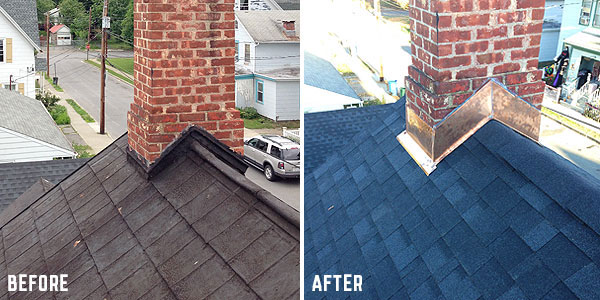
It’s often said that the roof and the foundation are the most important parts of a healthy house, and it’s true! Our roof was kind of a mess—a mix of sheet metal and metal shingles, all covered in layers of tar. The age and condition of the roof can make securing a homeowner’s insurance policy and a mortgage difficult, and basically we had to have it replaced ASAP. We got three estimates months before, but estimates are generally only valid for 1-3 months, so we had the same companies come back to give us new quotes after we closed. The new quotes were much, much higher than the original quotes, for lower quality materials no less! It was awful. I resented the companies so much that I didn’t even want to try to negotiate and work with them. I did find out some good stuff because of it, though!
1. Big-box hardware stores such as Lowe’s and Home Depot subcontract all sorts of work to local contractors (siding, windows, etc), including roofing! The difference between going through a place like Lowe’s and directly to the contractor might seem insignificant, but it isn’t: the big box store pricing is regulated, so they can’t arbitrarily jack up the price just because they think you can pay more. Even if you don’t end up hiring them, I highly recommend getting an estimate from Lowe’s, if only so that you have a baseline idea of what a fair price is for the job. The estimate is free, and I found them great to work with. I could easily dedicate an entire post to roofing (maybe I will—are you interested?), so I’ll move on…
2. Because roofing is significantly expensive, bigger roofing companies often offer financing plans for the job—so even if it’s more expensive than you were anticipating or have cash on hand for, you may be able to work something out directly through the company. Additionally, Lowe’s offers a consumer credit card with low-interest extended payment plans, and they’ll work with you to increase your credit limit to cover the cost. Roofing prices vary drastically by the size of the house, the materials, and the scope of the job, but the point is this: get lots of quotes, ask for references, and remember that you don’t necessarily need to have $10,000+ in your pocket to pay for it. Even if you have a great home loan with a comfortable renovation budget (or just a bunch of money in the bank), you still may want to consider financing stuff like this separately if you’re comfortable taking on another monthly payment, especially if you have lots of work ahead of you. Surprises (like rotted box gutters!) happen!
ELECTRICAL
Admittedly, electrical issues are one of the most intimidating parts of even thinking about buying an old house. A lot of people think that they need to have every last bit of wiring removed and replaced immediately, but in general that isn’t the case at all! Knob and tube wiring is generally considered a real hazard and should be removed, but “newer” types of wiring are often in fine shape, even if they’re very old. Even if the outer casing on old wires looks cracked or frayed inside an electrical box, remember that the ends have been exposed and messed with since their original installation, and the stuff going through the walls is probably in much better condition. A good, honest electrician should be able to give you a sensible evaluation of the age and condition of your wiring, and the urgency of replacing it. The advice from our electrician was basically to replace what we could, when we could—but no hurry. Still, there are some things to know…
1. Outlets! Lots of old houses will have ungrounded two-prong outlets. Obviously the modern standard is 3-prong grounded outlets, and having two-prong outlets everywhere gets annoying really fast. Consult your electrician about upgrading the outlets—in many cases, two-prong outlets can be swapped for 3-prong simply by grounding the new outlet to the metal box, or replacing it with a GFCI receptacle. GFCI receptacles are fairly expensive (about $30 each), but a basic grounded outlet is really cheap—like $1, a bag of grounding tails is something like $7, and a receptacle tester to make sure everything is wired correctly is like $3-4. This kind of thing is within the abilities of any normal homeowner with a little research, or your electrician might charge you $10-$20 an outlet to do it for you. Not a huge deal.
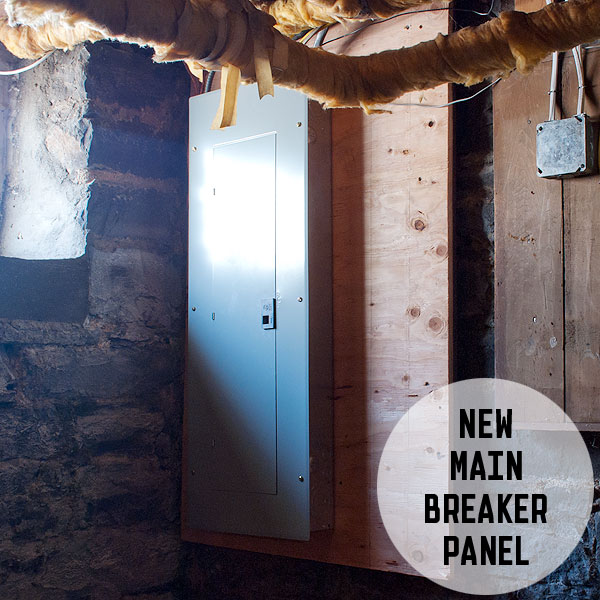
2. Main Electrical Panel! Lots of old houses have scary old service panels. Both fuses and circuit breakers are pretty much equally safe when operating effectively and wired correctly, but your electrician and home inspector should know which types of panels to watch out for. Our house was split into two apartments, so there were 2 separate breaker panels. One was fairly new-ish, and the other was an old Federal Pacific panel with Stab-Lok circuit breakers—which has pretty much been a known fire hazard for about 30 years because so many of the breakers were defective. Yikes! Luckily, replacing a service panel isn’t a huge deal, either. Existing wiring can be removed from the old panel(s) and tied into a new one. Along with a few assistants, our electrician had the whole job done in less than a day, and it cost $1,400.

3. Service to the panel! A very, very typical upgrade to old houses is actually increasing the overall amount of electricity running to the house—usually from 60 or 100 amps to 200 amps. As times have changed, as have our electrical needs, so many old houses are just under-electrified and not equipped to handle all of the things that we expect to use electricity for (appliances, computers, lighting, A/C units, etc. etc.). Included in upgrading the panel was also upgrading our service from 100 amps to 200 amps—meaning that not only do we have a new huge panel with more space for new circuits than I think we could possibly ever use, but enough electricity running into the house to power it all. It all runs through a fancy new grey PVC pipe, through a new meter pan, and into the new breaker panel in the basement.
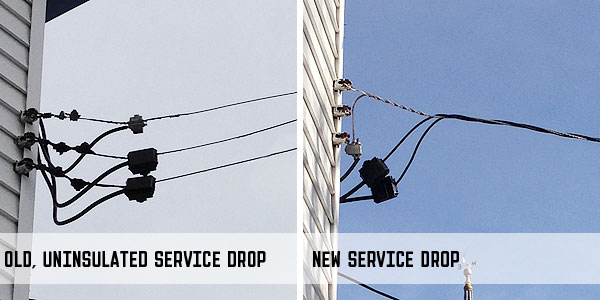
3. New Service Drop! The electrician is only allowed to work on electrical from the point of attachment (where the power line attaches to your home) downwards, however. So even after we had our panel and the wires feeding it upgraded, the wires from the pole to the house were still ollldddd. I think we were the last house on the street still rocking uninsulated triplex wire! I called the utility company to find out how to get that wiring replaced, and it only took them a couple of weeks after the electrician submitted some paperwork for them to come out and replace it. As far as I know, in most places this is a free service, assuming the utility company also deems your service drop outdated and in need of replacement.
PLUMBING
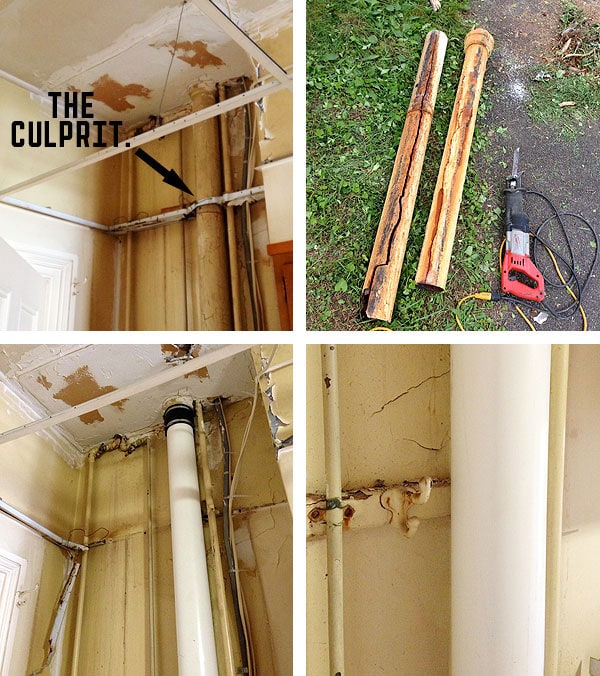
1. We dropped about $1,300 right off the bat on fixing various plumbing issues: buying and installing a new toilet, replacing leaky valves and a large section of the waste line—that kind of thing. The house had been drained while it was vacant, but extreme temperature changes are still very hard on old plumbing, even when there isn’t water in them. Cracked sections of cast iron pipe can be patched in with new PVC. Where we’ve had to replace plumbing, in general we’ve replaced with PVC for waste lines and PEX for supply lines, which is much cheaper than copper (and, supposedly, lasts longer and is less prone to damage).

2. New Boiler! The biggest plumbing issue (and headache…) we had to deal with was the heat system. The house had a very, very old oil-powered boiler, but the oil tanks had been removed and remediated by the estate prior to sale (note: if there are oil tanks on the property, those should also be inspected for leaks prior to buying. You do NOT want to deal with remediation!). The cast iron hot water radiators seemed to be in fine shape, but they would need a new boiler to make them actually radiate heat. Because natural gas is much cheaper and cleaner than oil and natural gas boilers are more efficient, we decided that the smartest thing we could do was to convert our heat system to natural gas. Luckily, Central Hudson currently has a gas conversion program specifically for homeowners looking to convert from oil to natural gas, but do not have current gas service. Running gas from the main to the house is essentially free (you do have to pay a $500 deposit, but it gets returned after your equipment is installed), but would normally cost a few thousand dollars without the program. I’m guessing this sort of program is happening in a lot of places, though, so definitely check with your local utility company if you’re interested in doing something similar!
From there, it was a matter of installing the new boiler—which, thankfully, ended up doing double-duty as our tankless hot water heater for the whole house. It’s worked out great, by the way. This is another very expensive upgrade, but prices vary significantly based on the type of equipment used, the plumber, and the size of the system (our house is about 2,400 square feet and we have 11 radiators). Our upgrade came in at just about $12,000—which is a whole lot of money. But at least in New York, there are rebate programs in place for installing high-efficiency equipment, so we actually got about $1,500 back after our plumber submitted the paperwork.
But, again, this isn’t necessarily something you need cash on hand for. Central Hudson’s gas conversion program has its own financing, and local banks and credit unions also often offer home heating loans. Additionally, New York State has NYSERDA—the New York State Energy Research and Development Authority, which is geared in part toward helping homeowners understand and finance energy-efficient upgrades to their homes. I didn’t find out about this until it was too late (impending winter really put a deadline on the boiler replacement!) but it’s a great program: starting with a free home energy assessment, working through the program may qualify you for cashback incentives, special financing, or even grants to help pay for the upgrades. I definitely plan to get an energy assessment through NYSERDA soon, and I’m hoping it helps us make other energy-efficiency upgrades more affordable!
PHEW. I could probably go on and on and on forever, but those are the major things we’ve encountered and had to learn alllll about in our first year of homeownership! It’s not all flowers and rainbows and fun, but that’s OK. Even in moments of panic and uncertainty, I still completely love our house, I love Kingston, and I’m really happy that we’re doing this.
If you’ve bought an old house, I’d love to hear what you can add to this list! And if you’ve bought a house at all, what are some of your most memorable home buying moments? If you need to jog your memory, cheek out all the home buying moments postcards!



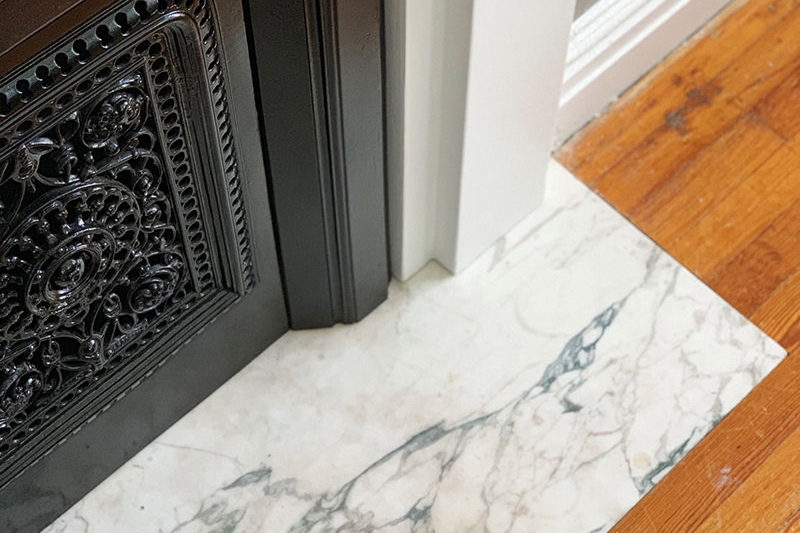
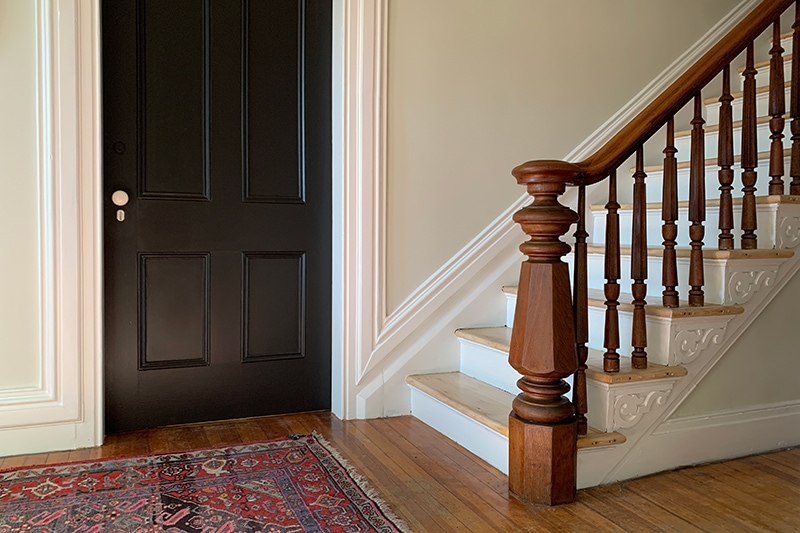
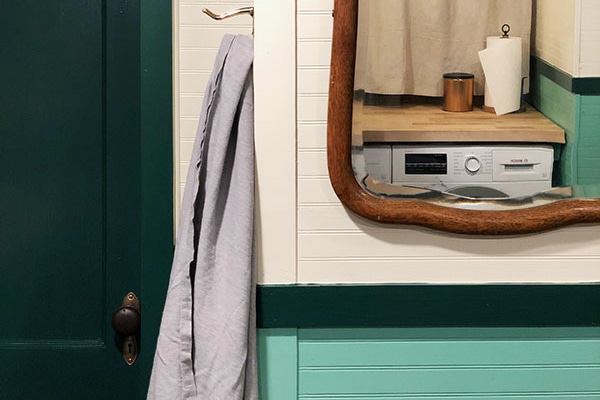

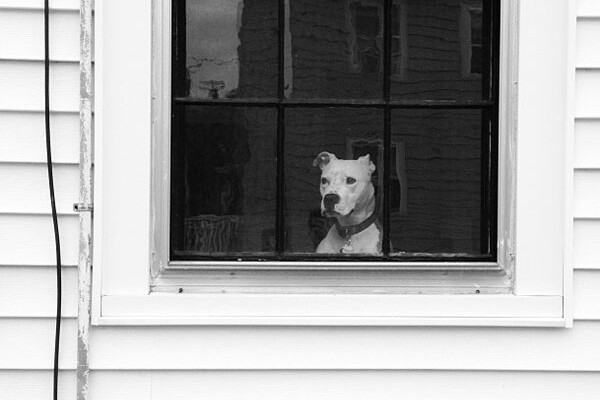
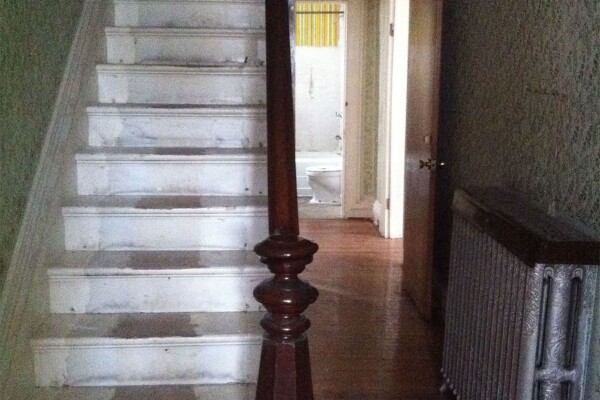

It’s nice reading about someone else going through all this kind of stuff! We live in the UK so some bits are a different but overall the process of renovating/redecorating/upgrading is the same here – we had to replace all our sockets, get new windows, a new boiler, and get our roof sorted (still isn’t fixed properly though!). It’s a massive labour of love, but hopefully worth it all at the end!
I bought my condo the day after I started looking at condos. I decided a couple weeks earlier to look into home buying and so a real estate agent took me out to look at 3-4 condos in my price range. I ended up buying the first one I looked at the next evening!! There was a bidding war and I went way over asking. It was kind of insane. But 5 years later I am still in that condo and I love it!!
Good list! I actually have a FP breaker panel, but one that didn’t need to be replaced, The Federal Pacific box that is a fire hazard has Stab-Lok circuit breakers that have a long history of arching problems. I have a Federal Pacific box that was mostly used in light duty commercial work and has Pushmatic breakers. Why my house has a light duty commercial breaker I’ll never know, but just an FYI not all FP panels are bad!
I think the thing I was most unprepared for was how much work my house is. I love my 1923 bungalow so much, but I won’t say that when something breaks how I wish I could just call a landlord to deal with it. ha.
Thank you——I amended the post to fix that! I forgot that it was only certain types of breakers.
This is all really useful information. I’ve now bookmarked this post for future reference as my husband and I are only interested in old houses. Thanks for putting this all together Daniel.
Great post! We have a house from 1900 and we’re dealing with electrical issues now. All the wires running to the box are new and all the wires attached to the outlets are new but some of the outlets aren’t grounded. Turns out someone attached the new romex to old knob and tube in the attic and then covered everything with blow in insulation. An outlet overheated and the side of it melted the other day. The breaker never tripped since the ground wire was useless. Luckily we were home and smelled the burning plastic.
My first home purchase was a 92-year-old historic house when I was 26. It had no kitchen, no bathroom and several walls and chunks of floor missing. I too was addicted to HGTV and thought the remodeling process was fast and fun. Of course, it was neither of those things. The most humbling investment was the very first one, which required spending thousands of dollars to shore up the sagging original hardwood flooring in every room. The most painful upgrades by far are the ones you can’t even see.
Overall that remodeling process was incredibly painful and expensive yet I still loved doing it and hope to remodel other old houses in the future. The things I learned from that first remodel will make all the others far easier.
In one house, the inspector missed rotting exterior panels covered by bushes (we had to rebuild an entire wall) and a leaking shower pan. Though he refunded the inspection fee, it was nowhere near the cost of repairs or lower price we might have negotiated had those problems been flagged during inspection. Current house: the inspector missed a leaking oil tank–big mess and cost to replace. Reliable contractors make a huge difference. You’re fortunate to have found good electricians and plumbers early on.
We’re getting ready to buy a MAJOR fixer upper (we’ll probably take it down to the studs) and reading all of your trials, tribulations is pumping me up for it. I know we’ll be benefitting from your experience as we figure all of this ish out. Keep the info comin’!
Most memorable during the process?
We lurked Trulia like obsessive freaks, and any time a new house came on the market in our price range, we’d drive up to northwest CT from NYC via motorcycle to check it out. Lots of homes in our price range were complete dumps or in terrible locations—so it was easier to do a driveby than set up a viewing. During the ride up to the house we ended up buying, the scenery was so magical and amazing that we were mentally crossing our fingers and repeating “please don’t suck, please don’t suck” inside our helmets—until we drove by the place, which was directly across the street from a working farm, and not a complete heap of crap.
I still go out to the end of the driveway to look at the horses for a mental de-stress during reno days. I’ll never forget that ride.
When we purchased our first old house in 2008, we were just like you- we accidentally found it, fell in love with all of the charm and beauty and had absolutely no idea what we were doing… I loved that house, but we wound up spending A LOT of $ on deferred maintenance projects. But we learned a great deal.
When we moved last year we were much smarter about the buying process but now committed “old house people.” It made the buying process excruciating, but we ultimately wound up with an old house (built in 1790- the second owner is buried in the local cemetery!) with little surprises.
Here are some thoughts on buying an old home:
1.). If you can, try to find a home inspector that specializes in old houses. We also found our own home inspector since we felt we were screwed by the one recommended by our realtor in 2008.
2.). We looked at a bunch of old homes that you could tell needed a ton of work, but we had a hard time being specific and putting together a project list and budget. We didn’t want to bid on a house without having a pretty accurate renovation budget, so we hired a local contractor that specialized in renovating old homes (recommended by our realtor, who we trusted) to walk through a few houses with us and point out deferred maintenance projects, ideas for upgrades, kitchen renovations, safety issues (electrical, plumbing, etc… ) We paid him about $300 to walk through 2 houses with us, and wound up not putting a bid on either one because the renovations and deferred maintenance projects would have tacked on $200-300k onto each asking price, and even if we negotiated it down it would still be over budget. We felt it was $ well spent.
3.) Ask the sellers for a breakdown of yearly utilities- water, gas and/or oil, electrical. In our first house we moved from a tiny apartment into a 2100 sq ft. home with NO insulation. Our first gas bill was $600 and we were freezing with a newborn in the house. Ugly times. During our most recent home search, we were seriously considering a home but I could just tell that it was cold in the winter. When I asked for a copy of their annual oil bill we discovered that the owners were spending $9000 a year on oil! Yup. To convert to gas meant asbestos remediation and a bunch of other work- another $30,000 to $40,000. No thank you. But that house was truly gorgeous!!! Sigh.
4.) Get the chimney inspected, but only use someone certified by the Chimney Safety Institute of America. There are tons of scam artists in this industry and it is very easy to scare the daylights out of a new homeowner who knows nothing about chimneys but also does not want to gas their entire family. Con artists will tell you to get a new chimney liner for $15,000, etc… This has happened to me and too many of my friends. Don’t use the coupon in the local valpak. Go the http://www.csia.org and use someone in their database.
Old homes are truly special. I will never live in a new home. But it is easy to get sucked into all the beauty, charm and history of a house without really understanding the time and expense that comes along with all that specialness.
You are so right about checking for leaks in oil tanks before buying. Here in Portland in ground tanks are really common and as a result is super hard to know if there is a leak and remediation is expensive. When we bought our house I was super concerned about the in ground tank because the house had been empty for over a year the previous owner was infirm so I was sure she didn’t have it checked regularly. And I was right, not only was there a leak but it was huge. The tank guy told me there was a leak when he walked into the backyard based on the sheen of the soil. Given his estimate to fix it all which included pulling up several very established plants and several tons of dirt we made a counter-offer to the bank which like most shortsales was horribly unresponsive and said nothing about the counteroffer and we fell out of escrow. That was insanely stressful, but I am a lawyer and I know that you can still close the deal even if you are no longer in escrow and my agent agreed that the bank would probably get back to us on their own schedule. The seller’s agent was also really supportive of our offer, so we all crossed our fingers and waited several weeks for the bank to get their shit together and they accepted our lower offer! Even better I had used the extra time to find out that we didn’t have to remove the old tank or the soil because we were making a cash offer and I found an alternative method that involves adding microbes to the soil and tank in 10-15 years they should have eaten all of the contamination so if we ever sell the house the contamination will be taken care of by then. Plus is cost a fraction of the original remediation plan. The money that we saved from our lower offer paid for our new high efficiency furnace which we were going to put in anyway since the city offers the same deal on the gas hook up as Kingston. Ultimately the leak ended up saving us a ton of money, but falling out of escrow was one of the scariest moments of my life.
This is a great wealth of information for anyone in the buying process or considering a renovation project! I’m currently on the hunt for our second home and I’m considering both new construction and a renovation project. It’s always nice to hear other peoples personal adventures in home buying. Thanks so much for sharing~
Great Article! Home buying/owning is an event/experience all unto its own, I believe. You are brave! But I do think you hit the nail on the head, whenyou said that information is the power to assuage those fears. How did we live before Google?
so the first paragraph of this is like an excerpt from my diary so, hey there soul mate. you’ve been doing an awesome job, dear sir.
We bought a 1906 house last year, and it was in decent shape, really. Still lots of work to do. But, the one thing I regret not knowing (and another commenter noted this too) was getting the annual utility bills. Turns out, the former owners were needing their propane tanks (for heat and food) filled twice a month. We got a bill for $1000 right after Christmas. January ran us $1200/mo. RIDICULOUS!! On the flip side, it’s making us really delve into the efficiency of the heating system (not that we can afford to replace it, but at those propane prices, we need to do something!), and because it’s a second house, we are looking heavily into automated systems that will allow us to regulate the thermostat, and monitor the property with some security features.
Thanks, Laurie! You’re definitely right. Our home-buying experience was sort of weird overall, and part of that was dealing with an estate (only through our realtor and lawyer, mind you) who didn’t seem to know anything about the house or seem to care much about it at all——the realtor told us they hadn’t even driven up from Long Island to take a look at the house they’d inherited! I don’t think we really had a way to look at utility bills, and given that only half of the electrical system (the downstairs) was even hooked up and the heat system would be replaced with gas, it didn’t really seem all that pertinent. We did ask lots of friends and family who we knew were homeowners to give us their best estimates of what they spent on that kind of stuff, so none of it has been TOO surprising. Nothing really prepares you for that first utility bill, although what you’re paying seems like a TON of money to me (we have gas, not propane, though”¦). IDK how big your house/system is, though. Our gas bill (heat/hot water) has been about $250/month this winter, which seemed like a ton of money to me but I guess isn’t so bad”¦
It DEFINITELY sounds like an automated system would be a good investment for you. I can highly recommend the Nest thermostat——it’s been terrific for us!
Thanks for mentioning numbers on your heating system with the gas conversion, Daniel. I would kill for $250 heating bill. How much time are you spending at the house with heat at normal levels? I purchased my first house in western Mass last fall. It is a rediculously cute 1920s English cottage style house with under 1500 sq feet of living space plus about 550 sq feet walk up unfinished attic with insulation that I describe as stupid. It is heated on oil with steam radiators with a boiler that is approaching 40 years old. So I knew that it would have to be replaced this year and I was just going to have to eat the cost of oil for the first winter. I did get 5 years of past oil bills from the sellers (also an estate sale, with a note that their mother had been in her 90s and kept it quite warm). So my ever hopeful brain rationalized that I would cut them significantly and it would only be for one winter. Well thank god winter will soon be over because $650-$850 oil bills per month are a killer and slowed me way down on working on other parts of the house. This was a good reminder to get a new system in the works NOW.
Yikes! That’s a lot of money. I’m so sorry!
We spend about half our time at the house——it really just depends on what’s going on during any given week. We keep the house at 55 degrees when we aren’t there and 65 during the day and 55 at night when we are there. It’s not exactly balmy, but it’s fine! Our house is pretty much uninsulated (the walls are filled with brick and mortar “insulation,” which has an R-value of less than 1”¦), and the space between the upstairs bedroom ceiling and attic floor has blown-in cellulose insulation, which I’m guessing is pretty old but does seem fairly effective. We plan to do more insulating and that kind of thing as we renovate”¦there are lots of ways we could up our energy efficiency and hopefully bring our utility bills down a bit and obviously minimize our environmental footprint.
I don’t know what kinds of programs Massachusetts has in place, but I’d definitely encourage you to look into converting to gas! It seems like it really shouldn’t cost so much to heat a house that size. Insulating will DEFINITELY help, but a 40 year old oil-powered boiler is just not going to do you any favors! (if asbestos is an issue with the old boiler, remember that you can usually leave it in place and/or encase it instead of having it removed and incurring the cost of asbestos abatement)
Whew! that was exhaustive!
As a reader from back when you first moved into your current NY apartment, let me just say that it’s been really fun watching you go through this journey of home ownership. Here’s to many more great years in your home (and here on the blog!)
I think my first clue was when the home inspector laughed at me, “I hope you like projects.” But the thing is, I do.
We bought our 18th century ‘weekend place’ in the south west of France about 17 years ago, it was love at first sight and still is even though it has sucked money from us ever since :). I am now drawing up plans for the renovation of the stone walled barns attached to the house which have never been touched since they were built. Everything has to be done, there is no plumbing or electricity so the sky’s the limit on what I can do. I plan to make it into my dream space using salvaged materials (thinking: cast iron factory windows, new-old oak floors, etc.,) I am so excited it keeps me awake at night!!
This sounds amazing. Good luck!
One other thing: A couple of houses back, the sellers bequeathed us a tidily organized folder containing absolutely every bill related to house repairs and appliance servicing they’d ever had (plus all warranties and manuals for everything from the stove to the furnace). It was a godsend to know about reliable service people who were familiar with that older house and had their own records. When we sold it, we passed on that folder, with our own decade of bills and service work added. That sort of information can be invaluable for taxes, insurance, questions from potential buyers. We also had available at our sale-by-owner open houses 2 years of utility bills.
I recently purchased my first row home which was built in the 1930s, about 1200 sq ft and has a new natural gas furnace. I considered making an offer on a home with the same floor plan but it had an oil fueled boiler. I did some googling and learned oil cost 3x more than natural gas. Asked around at work and someone with similar square footage said they were paying $2,000-3,000 per winter to heat their home. This would have put the home completely beyond more budget so I decided not to make an offer. This winter has been harsh and my last bill was only $185 which isn’t bad considering I keep the thermostat at 72 while I’m home, 70 at night.
Great post! I bought a 100 year old house 3 years ago out in the country – it hadn’t been maintained and everything big needed to be done. I got the price down as much as I could but walked in with eyes wide open. Mostly anyways, old house are a Pandora’s box but I love her and wouldn’t trade her. I just keep plugging away – one day my vision will be realized. Love reading your blog – you give me hope on the days I need it. Thanks :-)
If we never took that first leap to find out”
You have such a way with words, and are truly such a talented writer.
I gotta remember to come back to this page one day when I am headed out of my condo for a beautiful old fixer. Not only your great post, Daniel, but everybody’s comments are just so enlightening! I too have been a reader since you were in that very first apartment, and love this journey you and Max have been on. You are for serious living my house-dream, even with all the headaches.
On the side, any Californian readers know if CA has a program like “NYSERDA—the New York State Energy Research and Development Authority”? Because that is pretty awesome and I want one for us.
Hi Daniel,
This breakdown was great and I saw Anna also wrote a post for the same trulia post card series – I would love to see more of these on other blogs but when I click the link it just brings me to the trulia site with no list of blogs they have asked… Any ideas how I can find more?
Thanks!
I’m not sure! I figured that Trulia would link to all of the posts as they were published, but maybe not? I have no idea who else participated! Sorry!
Wonderful and informative post. And a huge thank you for including the repair bills. 1892 house over here (northern NJ). Two-family, split down the middle, two basements, two electric meters, one water supply. The house was remodeled by my dad in the early 90s so most of the important, big ticket work (roof, plumbing, electrical, foundation) was done well and up to code. Many of the unique features of this older home were erased to make way for renters’ needs (dad kept this as a rental property until I bought it in 2001) and I have been slowly restoring it to it’s former glory. But gosh darn it if I don’t want to shake my fists at the sky when I am surprised with a raccoon’s nest in the chimney that had to be cleaned out, chimney thus lined, and oh, this CAST IRON SEWER PIPE from the early part of last century should surely be removed and replaced with PVC at an added cost to an already hefty job price. I guess my dad missed a few things…
My partner and I bought a house about a year ago on a spur of the moment kind of logic and I have to say that this post resonates 100%. Thank you!
I found out that I need to save all the records for home improvements as the costs can be deducted from any profits I make at time of sale, resulting in lower taxes on that sale. Not maintenance, just improvements (replacing carpet with hardwood floors is a deduction, repairing sloping hardwood floors is probably not).
I bought my 1957 house from the original owner. It’s in great shape, but some things are better than others. The furnace, water heater, appliances were all on their last legs and needed replacing – boo. But I got to pick appliances I liked, and upgrade to energy efficient models – yay. All the original cabinets were custom built on site from mahogany – yay. California houses from the 1950s have no insulation – boo.
The main reason I like to buy older houses is that builders used to build to last – cabinets, windows, tile work – it’s still going strong after 60 years. Most new homes built today wear out a lot faster, and require replacements in 20 year cycles.
The worst part is every time we are ready to do a purely cosmetic renovation – yay new bathroom – we realize that we need to use those funds for a no-fun maintenance repair – boo French drains.
I would like to expand on the topic of insulation and older homes. Can there be such a thing as air equilibrium? After a period of developing horrible allergies to stuff in the air, I noticed, as I rented, that I felt much more comfortable living inside older construction. Generally these were places that were not up to date insulation wise and I thought that that helped the building and me to breathe. But what about heating in winter? While I took the step of sealing off most windows with plastic sheeting, I started discerning the layered arrangement of the interior of my present living space. The farmhouse walls, possibly pre-revolutionary, are constructed from two layers of wood. The inside layer is flat grained clapboard and the outside layer is wooden shingles. The living space walls are finished in plaster. There is a walkable attic space and the fireplace runs in the center of the building such that every room has a side of the fireplace, which I do not engage, except for some occasional candles, due to allergies. The ceilings are low and my unit is on the second floor. There does not seem to be significant drafts and the layering effects of wood and floor plan seem to provide a cumulative air insulation from the cold as I am able to live comfortably with my temp set at 50 even when it is in single digits outside. (Needless to say my utility bills are very low.) When there are severe temperature drops, the interior temp seems to fluctuate only by about 2 degrees if the setting is simply kept to 50 degrees. I have read that adding insulation to older structures can cause moisture problems and I do not understand how that takes place, but my allergies have made me particularly sensitive to the insulation effects of unmodified old building craftsmanship. I am wondering if better heating strategies for older buildings could involve room to room space type heating rather than systemic temperature adjustment or indiscriminately piling insulation material onto wooden ultrastructure in an attempt to form perfectly sealed enclosures. Would appreciate further references about this.
Such a wonderful post! We are hitting so many of the same points as you with our house after being in it for nearly a year now. We bought ours rather quickly as well, when only a month prior had no thoughts on buying at all. These old homes have a life of their own, sometimes we decide what to renovate and sometimes our house decides for us. We love following your progress!
My mom bought an old house when I was in high school, and I still remember some of the houses that got away longingly. Old houses are so just so cool. Since you went through a Martha Stewart phase (and what house lover hasn’t?), have you read her “Martha Stewart’s New Old House,” book? She writes about the renovation of one of her houses in Connecticut. In great detail. Its great.
YES!! I LOVE that book! The detail is amazing and insane, and I love how totally anal she is about everything. The day-to-day diary is my favorite section. It’s so….Martha.
Plus, that picture on the front? Such a dorky 80s look on the contractor (who was her brother right?). After I left that first comment I totally ordered myself a copy of the book so that I can reread it whenever I want. I’ve read it twice, but both times from the library and its been quite a few years.
Luckily, sounds like you had a good agent, but if for anyone buying, it’s usually a good idea to find lawyers and inspectors independently of the seller’s agent. It is not only a conflict of interest but there is a possibility of fraud, as some very sad cases in Brooklyn and elsewhere around the country have shown.
Seriously this post is my life right now! We are in the last days of escrow on our “new” old house and its literally been roofing, windows, electrical, copper wires, and non grounded outlets talk for the last few days. Matter of fact we just got an email of estimates from our contractor on work that we will need to tackle within days of getting keys. Our house isn’t as old as yours, it was built in the late 40s, but so many of the same issues are relevant. Thankfully along the way previous owners tackled many of the upgrades to get it up to current code standards. The roof is only 7 years old, the water heater was replaced a couple months ago, the electrical panel was upgraded a few years back, and theres no knob and tube, but there are still some things that need to be addressed. When we sold our newer builder grade mini mcmansion style house to purposely downsize into a small old bungalow I knew we were gonna be in for an adventure. Reading your blog, and others that are old house dwellers, makes me proud to join the ranks. Thank you for providing daily inspiration. You really help assure me that I can do it.